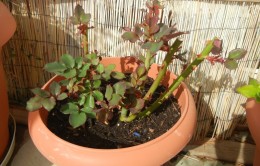
Indoor rose has faded what to do next. Home rose after purchase
Add site to bookmarks
How to prune a house rose in a pot
- Why else do you need to prune a home rose?
- Types of pruning home roses
- How to trim?
- Time to prune indoor roses
- Additional Tips
How to prune a house rose in a pot? This question sooner or later arises even among those who have just begun to get involved in indoor roses. In a flower shop, we get a beautifully formed bush or stem tree, but over time, the rose grows and loses its shape. Don't get upset if this happens. Restoring the shape of a flower with pruning is not at all difficult.
If the rose is not cut off, the rose grows, which spoils its shape.
Why else do you need to prune a home rose?
Pruning rose bushes is an operation of paramount importance, it gives the plant a harmonious and graceful look, guarantees excellent flowering every year, helps to avoid intertwining and tangling of branches, as well as getting rid of overgrown, frail or dead branches that are prone to diseases and pests.
On young rose bushes, it is useful to do the so-called sanitary pruning, best of all in spring or autumn, although theoretically it is possible at any time of the year. Sanitary pruning will allow you to get rid of not only dead or damaged branches, but also from too weak shoots that are cut just above the main branch.

Weak or strongly interfering processes are usually cut off.
Shaping pruning helps to maintain or give the desired shape ornamental plants. Rejuvenating pruning, which is done at intervals of several years, is intended to restore vitality to the bushes of a house rose, which have become too tall and thick over time.
Usually such pruning is done in late winter or early spring. All weak branches are removed, and the remaining branches are shortened.
Pruning roses is necessary not only to give the rose a beautiful look, but also to improve flowering. By cutting off the excess parts of the branches, we provoke the appearance of new buds.
In roses, pruning is done mainly to remove old and weak parts of the bush in order to rejuvenate it, stimulate new flowering, and make the plant less susceptible to pests.
Back to index
Types of pruning home roses
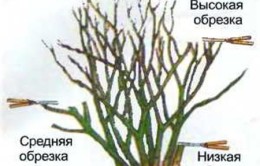
- Restraining pruning - needed to give the bush the appropriate size.
- Promoting pruning - to encourage flowering.
- Formative pruning - necessary to give rose bushes the desired shape.
- Apical pruning - done in plants to stimulate the growth of a rose bush in breadth.
- Anti-aging pruning - removal of old branches to rejuvenate the bush.
Back to index
How to trim?

The cut should be oblique with respect to the kidney and be at a certain distance from it. The optimal distance between the kidney and the cut is about 1 cm. It should not be too sharp (45 degrees is better) and is done in the opposite direction from the kidney. And the last thing: the tool must be well sharpened, then the cut will be clean, without burrs, which often contribute to the reproduction of pathogenic organisms.
You need to remove all dead, damaged and tangled branches that interfere with the development of the middle part of the bush. Full pruning involves cutting back all branches to encourage flowering and give the plant the desired shape and size.
Be sure to remove all wilted flowers. The fact is that the energy that the plant spends on withered flowers is not used to give birth to new flowers.
Back to index
Time to prune indoor roses
Pruning is one of the most important rose care practices. It is equally important to choose the right time for pruning. There are three ways to crop:
- short (spring) - remove branches affected by dry air and pests, and shorten healthy branches, which stimulates lush flowering;
- medium (summer);
- long (autumn) apical pruning - remove wilted flowers and stimulate secondary flowering in some varieties.
Winter pruning is done in February-March, when new buds begin to swell on rose bushes. It is very important that the pruning is done before the buds begin to open; if pruned later, it will damage the plant.
Summer apical pruning is done in early August and only for roses that bloom several times a year to stimulate new flowering.
Plants should be pruned whenever possible when the room is not too hot. It is better if the room is cool. At low temperatures, the flow of vital juices in the tissues of the plant slows down, and the damage caused by injury will be minimal.
home rose- This is a magnificent mini copy of the garden. This beautiful flower very popular among fans indoor plants. A rose that grows in a pot is a very capricious creature and for its fruitful flowering it will take maximum effort. But trust me it's worth it. A rose can decorate with its presence even the most unattractive interior of an apartment.
At home, only the dwarf species of this beautiful plant should be grown. The fact is that a garden rose has an extensive root system that simply cannot fit, even in the largest pot.
Rosa loves light and fresh air very much, so the best place where she can feel good in the summer is a balcony. If it is not possible to keep an indoor rose on the balcony, then you should place it in a warm, well-ventilated area. It is necessary to water frequently, but moderately, without flooding or allowing the soil to dry out. In winter, the rose should be watered less often and kept at a temperature of ten degrees. Fertilizers are applied only during the period of rapid growth, at least twice a month.
In order for the rose to bloom as long as possible, it needs to create a certain temperature regime, which is closer to cool than warm. In a warm room, you can achieve a long flowering plant, but for this it needs to be irrigated with warm enough water every two days. A prerequisite for flowering roses is a room in which there is a lot of light.
Plays an important role in the health and rapid flowering of home roses. proper watering this plant in summer. Watering is done in the morning and in the evening, but in no case not in the sun. The rose should be in moist soil almost constantly, but you should not allow waterlogging of the soil.

The soil-soil must be very nutritious and saturated.
Off-topic question ... Question on cottagesWe are constantly getting letters in which amateur gardeners are worried that due to the cold summer this year, a poor harvest of potatoes, tomatoes, cucumbers, and other vegetables. Last year we published TIPS about this. But unfortunately, many did not listen, but some still applied. Here is a report from our reader, we want to advise plant growth biostimulantswhich will help increase the yield by up to 50-70%.
Read...
It is good to take the soil for planting in the place where nettle thickets rage. Nettle does not grow in poor soils, this is a well-known fact.
The rose is very often attacked by various kinds of pests. This is a spider mite, and aphids, and a rose sawfly.
Aphids are washed off with an ordinary solution of soapy water, and this should not be a one-time treatment, it is desirable to carry it out once a week.
Spider mites and other pests can be killed with garlic. To do this, you need to take fifty grams of crushed garlic and pour 200 grams of cold water over it. When infused, for 15 minutes, strain, bring the volume to one liter. When processing, one and a half glasses of infusion are taken for ten liters of water, and in cloudy weather the room rose is washed with this solution. But you can buy the drug "Fitoverm" in the store, which you need to spray for at least a week within a month.
Transfer

In order for the home rose to bloom violently in the spring, the transplant must be carried out already in August, this will allow the roots to adapt and take root well. Otherwise, the rose will take root during the entire period of rapid growth and will bloom only by autumn. When transplanting a plant, you should try not to destroy the earthen lump, since the rose is very sensitive to damage to the roots and then gets sick for a long time.
An indoor rose should be planted in small flowerpots, since with an excess of space in a flowerpot, the rose will give a lot of greenery and rarely bloom.
pruning
This is an indispensable part of caring for a room rose. If you neglect pruning, the plant will be weak. With thin long branches and small rare flowers. Answering the question “when the main pruning is done”, usually in early spring, before the rapid growth of the plant has yet begun.

Some flower growers who are closely involved in breeding room roses want to achieve from it not only long flowering, but also large buds if possible. Pruning is carried out during the entire flowering period, removing newly grown shoots and leaving three or five buds on the main shoots.
Cut home beauty for good flowering and bush decoration beautiful shape.
In order to properly trim you need to know:
- First, all weak and underdeveloped stems are removed. As well as branches that are intertwined.
- No more than five strong shoots, of medium length, should be left on the bush.
- If the shoots are long, then they need to be shortened, leaving six live buds.
- If the sprouts are long, but not very developed, then five buds are left for further growth and development.
- When weak shoots appear, it is advisable to remove them, but if this is not possible, then three buds are left on them.
Caring for a beautiful but capricious plant
It is important that sharp tools are suitable for pruning, which will not leave a hitch on the shoot of the plant. The fact is that when trimming with blunt tools, torn edges are obtained at the place of trimming, and this is fraught with the development of various diseases and decay of the cut edge. Pruning should be carried out strictly at an angle of forty-five degrees, just above the living kidney.
In order to prevent new shoots from stretching out, the flower after pruning should be placed in a cool room and only after the first leaves appear, put on a sunny window for further growth. Small shoots that will appear during the period of violent growth are removed immediately so that all the forces of the plant go to the formation of beautiful buds on the main shoots.
After the first flowering of the room beauty, it is necessary to re-pruning so that the plant does not give strength to the growth of greenery, and after a while it can bloom again. All faded buds and small shoots are cut off, leaving three or five buds on the main layers.
If you follow all the rules of maintenance and cut it properly, then it will delight you with its flowering until the end of summer.
And a little about the secrets of the Author
Have you ever experienced unbearable joint pain? And you know firsthand what it is:
- inability to move easily and comfortably;
- discomfort when going up and down stairs;
- unpleasant crunch, clicking not of their own free will;
- pain during or after exercise;
- inflammation in the joints and swelling;
- causeless and sometimes unbearable aching pain in the joints ...
Now answer the question: does it suit you? Can such pain be endured? And how much money have you already "leaked" for ineffective treatment? That's right - it's time to end this! Do you agree? That is why we decided to publish an exclusive interview with Oleg Gazmanov, in which he revealed the secrets of getting rid of joint pain, arthritis and arthrosis.
Attention, only TODAY!
Decorate loggias and balconies, windows of houses. All summer they delight the owners with their lush flowers. But in order for the next year the plant to also bloom abundantly and for a long time, it must be properly cut for the winter, leaving only a stalk from each stem. Autumn pruning is carried out in order to strengthen the plant and its immunity before the upcoming wintering.
In addition, pruning for wintering allows you to rid the plants of unnecessary parts for which she does not have to spend energy. A rose cut off before the onset of winter forms more buds in spring, which means that flowering will be plentiful. After pruning for the winter with the onset of a new period of active growth, the emerging young shoots will be stronger.
In autumn, pruning is necessary for any roses, it contributes to a better wintering and reduces the likelihood of diseases. Pruning has a positive effect on flowers.
- Provides better access to air and light. Densely growing shoots are poorly ventilated, so the likelihood of developing rot and other diseases increases.
- By removing old and diseased shoots, the plant directs energy to the development of young stems. In addition, old shoots take away some of the nutrients that could be supplied to young and strong stems in greater quantities.
- Uncircumcised roses give all their strength to the nutrition of the stem, therefore, this affects the quantity and quality of flowers. If you cut the tops of the stems for the winter, then the root system becomes hardier and increases the survival rate of the plant.
- All unripe shoots and buds are pruned for the winter. This measure prevents decay and the development of diseases.
- Pruning plants before winter allows roses to start active vegetation in time in spring and not be late with flowering.
Trimming Rules
To properly prune indoor roses, you must first prepare the tools and the plant.
- Before cutting room or garden rose, you need to familiarize yourself with the characteristics of the flower variety. Different varieties are pruned differently. Some are subject to frequent pruning, or complete removal of shoots, while others are cut only small shoots.
- Decide on the purpose of the formation. This can be when the plant hibernates, spring, promoting active growth and flowering, or shaping pruning, the purpose of which is to give the bush a neat appearance. You can trim the stem to get a cutting for propagation.
- Pruning tools must be sharp, otherwise ragged cuts will remain on the stems, from which the plant may die. Sections are made at an angle and slightly higher than the last remaining kidney. The cut line is made so that it is directed towards the eye.
- First, thinning pruning is carried out, and then the main one. Thinning pruning allows you to shape the bush by removing excess shoots. This contributes to better ventilation and the distribution of nutrients between healthy and desirable shoots.
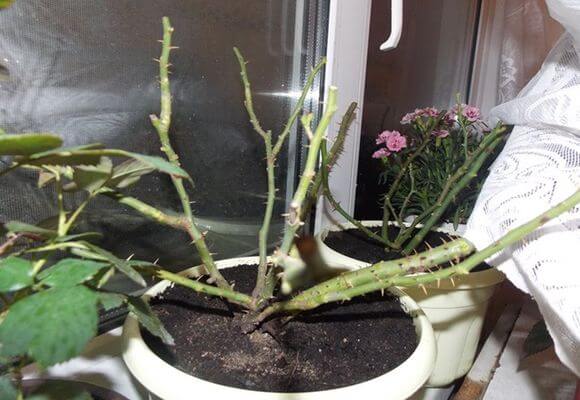
pruning
Pruning before wintering is necessary in order for the plant to winter well and the dormant period to pass successfully. Removing most of the stems allows the plant to accumulate strength for spring growth, in addition, weak or diseased shoots take some of the nutrition onto themselves, and at the same time do not allow a large number of buds to form. Leaving the bush uncut, greatly affects both the decorative qualities and the health of the plant. Weak branches are more likely to infect diseases. To prune roses in the winter correctly, you need to follow a few points.
- Five of the strongest and healthiest stems are determined on the bush, and the rest must be cut with a pruner. The diameter of each such shoot should be at least 1 cm, there should not be many branches, and the color should be dark green.
- On each of these shoots, five buds are noted, starting from the bottom. Then you can start cutting. You need to trim the stems quickly and in one motion so as not to damage the bark and not break the stem in the middle.
- Then determine the upper kidney, which must necessarily be external. From this kidney, an indent of 1 cm is made and the stalk is cut so that the slope is inward. This condition must be observed so that moisture does not linger on the cut.
- The middle of the cut should be white, this is an indicator that the stalk is healthy. If the middle is brown, then cut the rose shorter. The main principle of pruning roses is the ratio of the length of the root, and the size of the aerial part. They should be approximately equal. Subject to this condition, the principle of plant nutrition will not be violated.
- In this way, all the necessary stems are cut, and the sections on them are treated with an antimicrobial solution. This will help protect the stems from the penetration of pathogenic microbes inside.
When pruning roses, it is better to use the Lunar calendar and do this procedure in accordance with it. Roses for the winter need to be cut to the phase of the growing moon. It is believed that this way the plant will more easily tolerate pruning and will not get sick.
Pruning in this way can be done not only on indoor roses, but also on garden ones. After this procedure, garden specimens are prepared for the winter.
Care for roses after pruning
Garden roses are prepared for winter in early autumn. To do this, they clear the ground under them, remove cut stems, dried leaves and other debris. The earth is dug up and bushes are hilled. The height of the earth pile should be at least 20 cm. After that, when the first and persistent colds come, the bushes cover. To do this, they build shelters for the winter, consisting of spruce branches, cardboard shields and boards. Cover types may vary.
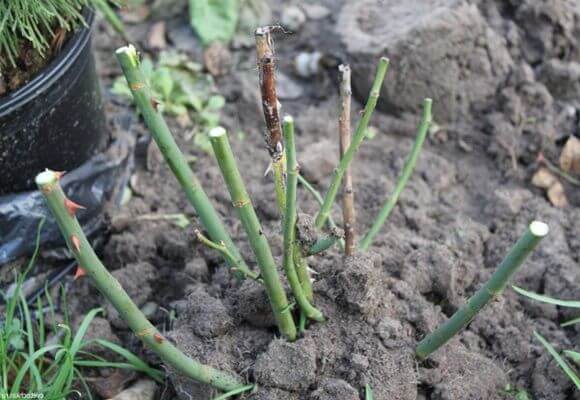
Temperature regime
Indoor roses after the pruning procedure are cleaned in a shaded place in a cool room. The temperature should be reduced to 10-15 degrees. If the apartment has a cool room, or an insulated loggia, where the desired temperature is kept, then the plant is taken there. If not, then you can put the pot on the north window, and fence off the place where it will stand with a film from the room. You can put pots between the frames if the windows are of the old type. In winter, the rose will not grow, and since it is devoid of almost all leaves, it needs minimal watering.
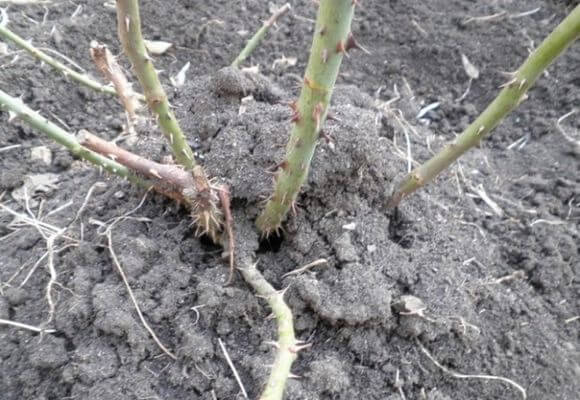
Watering and humidity
Watered so that the soil in the pot stood dry for a couple of days until the next watering. Waterlogging of the soil should not be allowed, otherwise, in a cool and humid climate, bacteria and diseases will begin to develop, the root system will begin to rot. Under such conditions, it may appear, characterized by a white coating on the stems and leaves. Drafts should not be allowed in the room, they provoke the development of rot. Sometimes you can spray the plant with a spray bottle. When the air in the house is dry, you can put the flower pot on a damp tray with gravel or pebbles, and make sure they are always wet. Feeding is also stopped.
Properly and timely pruning of roses allows you to increase the number of flowers, their quality and improve the decorative appearance of the plant.
Proper pruning of indoor hibiscus and the formation of its crown Proper pruning of ficus Benjamin and the formation of its crown
Today we will tell you about how to prune indoor rose, because this is one of the main conditions for the fact that your flower will develop and form correctly. Caring for roses at home requires a little work from you, but you will be satisfied with the result, because if everything is done on time and according to the rules, she will thank you in full, and your house or apartment will be transformed beyond recognition.
Should I prune my indoor rose?
The answer to this question is in the affirmative. When to prune a rose? It should be cut when the flower has already fully opened, and the middle is already almost visible. Pruning a rose is useful both for sanitary purposes: you cut off shriveled, dead shoots that only harm the flower, and for decorative purposes: you form a neat, decorative bush that will look the way you want it, and will not grow in a chaotic form.
How to prune an indoor rose?
We count 5 buds down from the flower, and cut off under 5 buds.


You can also prune the rose if necessary, for example, if you have large ugly knots on the stem, from a previous unsuccessful pruning, you can prune right under that place, and thereby bring two useful actions at a time. If the branch is thick and large, it will give a very good shoot.
What should be the cut? It must be done obliquely with respect to the kidney, it must also be about one centimeter away from the kidney, this distance is considered ideal, the cutting angle should not be very sharp, the ideal slope is considered to be an angle of 45 degrees. Trim with sharp scissors or a knife.

Reproduction of a room rose:
Cut cuttings should not be thrown away. They can be used for . To do this, we need to prepare them.
- To do this, we cut the flower, as you see it in the photo.

- You also need to cut off the two lower leaves.
- We put the stalk prepared in this way into the water, and wait until they have roots, after which the rose will be suitable for transplanting into a pot.

The second method of propagating a room rose is as follows:
- For this, we will take a large stalk, which was with several knots, from previous circumcisions, and cut off a flower from it, and also cut off the lower leaves.

- As you can see in the photo, the shoot turned out with a very powerful stem - an almost ready-made bush when it sprouts.
- Further in the pot, where the rose bush is already growing, we dig a hole in a free place and put our cutting there.

- We deepen this knot into the ground and press it. The rose should be watered every day, she does not like her earthen ball to dry out, and keep her not in the open sun, but in the shade.
Trimming an indoor rose is not difficult, and now you know how to do it right. The main thing is to do everything according to our advice, and a bush of this wonderful flower will delight your eyes. On this we say goodbye to you, we wish you a good mood, and your flower - the right pruning, until we meet again on our website!
To print
Anna MERKULOVA 06/24/2014 | 3532
Indoor roses are often on sale with flowers of various colors and shapes. But then the purchased beauty fades and the question arises: what to do next?
Rose care after purchase
I bought a bush in early spring, after a month the buds crumbled, the leaves began to curl up and fall off. I made a mistake thinking that flowering plant should not be transplanted. Now, after buying new varieties immediately transplanting roses into a new substrate, shaking off the roots from the old one, but at the same time I try not to disturb them much. I take a flowerpot a little more than the previous one. soil mixture I cook from leafy soil, peat and sand (60/30/10), add a little humus. From ready-made soils, you can use "Terra-Vita" with the addition of vermiculite. Good drainage is required. I put coarse charcoal on it (it will save in case of excessive watering), then I pour soil.
After landing watering plant with a solution of Fitosporin and put in a bright place with shading from the direct rays of the sun. About a week later, for the purpose of prevention, I spray the plant with Fitoverm (from spider mites), trying not to get on flowers and buds. 3 weeks after transplant feed drug Uniflor-buton (1 time in 10 days).
Roses bloom beautifully on the windowsill in spring, but with the advent of summer they begin to "sad". The flowers are not so bright, due to the dryness of the air, pests often attack the plants. I take my beauties out into the garden at the beginning of summer. It's amazing how they transform in the fresh air! At this time, the rose must be watered daily (avoiding stagnant water in the pan!), Remove faded flowers and spray frequently.
Indoor roses in winter
The real problems start when the central heating is turned on. Lack of lighting and dry air lead roses to a deplorable state. I experimented a lot and found two optimal options for myself.

1st way. You can keep roses away from batteries on a rack with artificial lighting at a temperature of 18-25 ° C. In this case, they can bloom in winter. Need in autumn cut shoots(cutting them in half) to give the bush a beautiful shape and for abundant flowering in the future. Watering- as the topsoil dries up (but the earth in the pot should not dry out). At temperatures above 20 ° C and good lighting, you can feed with phosphorus-containing preparations once a month.
2nd way which I use in last years, - send the rose to rest. In this case, there will be lush flowering and active growth in the next season. I I cut the shoots half, remove all the leaves, spray the stems with Fitosporin solution. I wait until the flower dries after spraying, then I put it in a foam box (household appliances are usually packed in such boxes). Cover with transparent film on top and - to the glazed balcony. I make sure that the temperature on it does not fall below 7 ° C.
In this position, my roses are until the end of February. In severe frosts (fortunately they are not frequent with us), I bring them into the hallway, where it is always cooler than in the room. watering rarely, only slightly wetting the ground. In the first days of March, I bring it into the apartment, transplant it into fresh soil. Starting in 3-4 weeks feed drug Uniflor-micro 1 time in two weeks. Then, when I have to water more often, and the roses begin to grow actively, I change the top dressing for the Uniflor-buton preparation and add it to the water for irrigation no more than once every 7-10 days.
To print